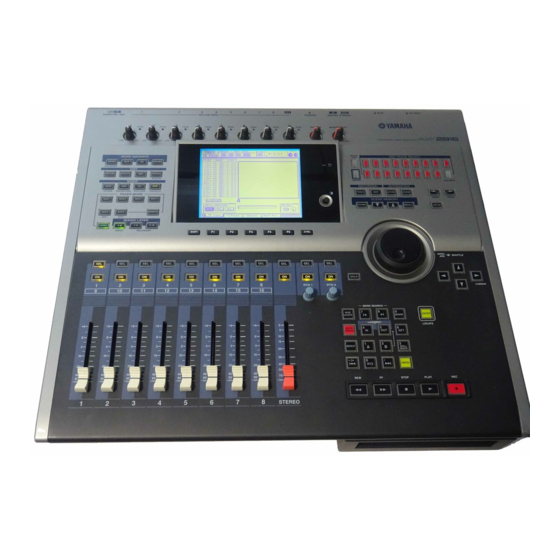Yamaha AW2816 Manual - Page 18
Browse online or download pdf Manual for Musical Instrument Yamaha AW2816. Yamaha AW2816 32 pages. Professional audio workstation, recording101
Also for Yamaha AW2816: Operation Manual (2 pages), Update Manual (2 pages), Tutorial (31 pages)

Phantom Power
As stated earlier, condenser microphones need an external power supply in order to work. This
is usually 48 volts. The mixing console will send 48 volts back to the microphone over the
microphone cable. Only inputs 1 and 2 of the AW2816 can supply phantom power to condenser
microphones. If more than 2 condenser microphones are to be used at one time with the
AW2816, an external phantom power supply should be used. These are available at most music
stores. The microphone should first be connected to the phantom power supply and then the
phantom power supply should be connected to the AW2816.
Microphone Pre-Amp
Next on an input channel is the microphone pre-amp. Microphones generally do not have very
high output levels. In order for the signal coming from the microphone to be recorded at a
sufficient level to be above the noise floor the signal must be boosted. The pre-amps job is to
boost the signal from the microphone. Typical microphone pre-amps have about 60 dB of gain
available. The AW2816 has 8 microphone pre-amps. Inputs 1-2 have XLR input connectors
while inputs 3-8 have 1/4" TRS connectors. The microphone pre-amps are identical on all 8
input channels but the input connectors are different. A XLR to TRS cable should be used to
connect more than 2 microphones to inputs 3-8 of the AW2816.
The 8 pre-amps on the AW2816, while sonically being very clean and transparent, have slightly
less gain. For most instances this is plenty but for recording quiet instruments or vocalists it may
be necessary to use an external microphone pre-amp.
A gain trim knob, located on the input channel, controls the level of each individual microphone
pre-amp. On the recording console this is usually located at the top of the input channel strip
while on some live consoles it is located right above the fader.
Peak Meter
The peak meter on a mixing console is normally right after the preamp. This is used to indicate
if the signal is clipping at the input stage. Some consoles have both peak meters and input level
meters while others simply have a peak meter. The AW2816 has a peak meter before the Analog
to Digital Converter and an input meter after the converter. The peak meter shows whether or not
the input signal is too high. The peak meter on the AW2816 lights up 3 dB before clipping. It is
acceptable to have the peak light come on periodically but if it stays on the input level is to high
and the gain trim should be turned down.
Phase Reversal Switch
Reverses the phase of the signal. Often if a signal is recorded with two microphones the
waveforms of the two signals will be beating in opposite directions creating a hollow or "out-of-
phase" sound. Since the waveforms would be beating in opposite directions they would begin to
15
